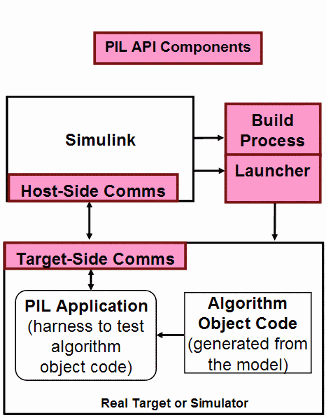Create PIL Target Connectivity Configuration for Simulink
Target Connectivity Configurations for PIL
Use target connectivity configurations and the target connectivity API to customize processor-in-the-loop (PIL) simulation for your target environments.
Through a target connectivity configuration, you specify:
A configuration name for a target connectivity API implementation.
Settings that define the set of compatible Simulink® models. For example, the set of models that have a particular system target file, template makefile, and hardware implementation.
A PIL simulation requires a target connectivity API implementation that integrates third-party tools for:
Cross-compiling generated code, creating the PIL application that runs on the target hardware.
Downloading, starting, and stopping the application on the target.
Communicating between Simulink and the target.
You can have many different target connectivity configurations
for PIL simulation. Register a connectivity configuration with Simulink by
creating an sl_customization.m file and placing
it on the MATLAB® search path.
When you run a PIL simulation, the software determines which of the available connectivity configurations to use. The software looks for a connectivity configuration that is compatible with the model under test. If the software finds multiple or no compatible connectivity configurations, the software generates an error message with information about resolving the problem.
Create a Target Connectivity API Implementation
This diagram shows the components of the PIL target connectivity API.

You must provide implementations of the three API components:
Build API — Specify the Simulink Coder™ toolchain or template makefile approach for building generated code.
Launcher API — Control how Simulink starts and stops the PIL executable.
Communications API — Customize connectivity between Simulink and the PIL target. Embedded Coder® provides host-side support for TCP/IP and serial communications, which you can adapt for other protocols.
These steps outline how you create a target connectivity API implementation. The example code
shown in the steps is taken from ConnectivityConfig.m in Configure Processor-In-The-Loop (PIL) for a Custom Target.
Create a subclass of
rtw.connectivity.Config.ConnectivityConfig < rtw.connectivity.Config
In the subclass:
Instantiate
rtw.connectivity.MakefileBuilder, which configures the build process.builder = rtw.connectivity.MakefileBuilder(componentArgs, ... targetApplicationFramework, ... exeExtension);Create a subclass of
rtw.connectivity.Launcher, which downloads and executes the application using a third-party tool.launcher = mypil.Launcher(componentArgs, builder);
Configure your
rtiostreamAPI implementation of the host-target communications channel.For the target side, you must provide the driver code for communications, for example, TCP/IP or serial communications. To integrate this code into the build process, create a subclass of
rtw.pil.RtIOStreamApplicationFramework.For the host side, you can use a supplied library for TCP/IP or serial communications. Instantiate
rtw.connectivity.RtIOStreamHostCommunicator, which loads and initializes the library that you specify.hostCommunicator = rtw.connectivity.RtIOStreamHostCommunicator(componentArgs, ... launcher, ... rtiostreamLib);
If you require execution-time profiling of generated code, create a timer object that provides details of the hardware-specific timer and associated source files. See Specify Hardware Timer.
Note
Each time you modify a connectivity implementation, close and reopen the models to refresh them.
Register a Connectivity API Implementation
To register a target connectivity API implementation as a target connectivity configuration in Simulink:
Create or update an
sl_customization.mfile. In this file:Create a target connectivity configuration object that specifies, for example, the configuration name for a target connectivity API implementation and compatible models.
Invoke
registerTargetInfo.
Add the folder containing
sl_customization.mto the search path and refresh your customizations.addpath(sl_customization_path); sl_refresh_customizations;
For more information, see rtw.connectivity.ConfigRegistry.
Verify Target Connectivity Configuration
To verify your target connectivity configuration early on and
independently of your model development and code generation, use the
supplied piltest function.
With the function, you can run a suite of tests. In the tests, the
function runs various normal, SIL, and PIL simulations. The function
compares results and produces errors if it detects differences between
simulation modes.
Target Connectivity API Examples
For step-by-step examples, see:
Configure Processor-In-The-Loop (PIL) for a Custom Target
This example shows you how to create a custom PIL implementation using the target connectivity APIs. You can examine the code that configures the build process to support PIL, a downloading and execution tool, and a communication channel between host and target. To activate a full host-based PIL configuration, follow the steps in the example.
Create a Target Communication Channel for Processor-In-The-Loop (PIL) Simulation
This example shows you how to implement a communication channel for use with the Embedded Coder product and your embedded target. This communication channel enables exchange of data between different processes. PIL simulation requires exchange of data between the Simulink software running on your development computer and deployed code executing on target hardware.
The
rtiostreaminterface provides a generic communication channel that you can implement in the form of target connectivity drivers for a range of connection types. The example shows how to configure your own target-side driver for TCP/IP, to operate with the default host-side TCP/IP driver. The default TCP/IP communications allow high-bandwidth communication between host and target, which you can use for transferring data such as video.Note
If you customize the
rtiostreamTCP/IP implementation for your PIL simulations, you must turn off Nagle's algorithm for the server side of the connection. If Nagle's algorithm is not turned off, your PIL simulations can run at a significantly slower speed. Thematlabroot/toolbox/coder/rtiostream/src/rtiostreamtcpip/rtiostream_tcpip.cThe code for your custom TCP/IP implementation can require modification./* Disable Nagle's Algorithm*/ option = 1; sockStatus = setsockopt(lFd,IPPROTO_TCP,TCP_NODELAY,(char*)&option,sizeof(option));
The example also shows how to implement custom target connectivity drivers, for example, using serial, CAN, or USB for both host and target sides of the communication channel.
See Also
piltest | rtw.connectivity.Config | rtw.connectivity.ConfigRegistry | rtw.connectivity.Launcher | rtw.connectivity.MakefileBuilder | rtw.connectivity.RtIOStreamHostCommunicator | rtw.pil.RtIOStreamApplicationFramework
Related Topics
- Host-Target Communication for Simulink PIL simulation
- Specify Hardware Timer
- Design Subclass Constructors
- Processor-in-the-Loop Verification of Simulink Models (Embedded Coder Support Package for ARM Cortex-A Processors)